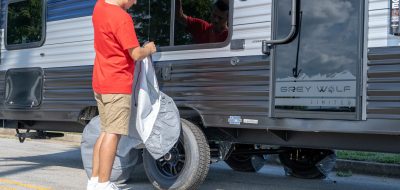Life in the Fast Lane
by Lee Barnathan
Lisa and Rich Johns of Uhrichsville, Ohio, know there are certain NASCAR—related activities one can only enjoy with an RV. While camping at Michigan International Speedway, Lisa Johns saw a helicopter fly into the track. Not being limited to just a seat in a grandstand, Lisa did a little investigating and discovered that this was how the drivers were transported to and from the airport. A guard told Lisa to come by after the race and he’d get them in to see the drivers.
Lisa, her daughter Hannah and son Richie met numerous drivers and got plenty of autographs from the likes of Jeff Gordon, Mark Martin and Michael Waltrip. Husband Rich came by later and talked to Jeremy Mayfield.
“This is probably the first time Jeff Gordon ever signed a Barbie hat,” Lisa mused. What the Johns family was doing was not just watching a race. They were participating in the time-honored tradition of tailgating.
Mobile Communities
Unlike those RVers who tailgate at football games, where one arrives hours before kickoff and leaves afterwards, NASCAR tailgaters often have been at the track all week, with some arriving 10-14 days early. As a result, by the time the races start at any of the 32 tracks on the Nextel Cup and Busch Series circuits, the tracks have become large cities.
Kevin Triplett, vice president of public affairs at Bristol (Tennessee) Motor Speedway, says that with 160,000 attending a race, Bristol is for one day the third largest city in Tennessee. And Joe Baumann of Erie, Pennsylvania, has a name for it: “Flag City.”
“Oh, Lord, yes. If it’s a flag, it’s-a-flyin’,” concurs Jay Baker of Murrells Inlet, South Carolina. “It’s a conversation starter. I’ll walk down the street and see a guy with a Dale Earnhardt, Jr. flag and a University of Alabama flag. Well, I’m a fan of Dale Earnhardt, Jr. and the University of Tennessee, so we’ll talk about Dale Earnhardt, Jr. and then we’ll talk about college football.”
Attend any NASCAR Nextel Cup event and there will be hundreds of RVs parked in the infield and thousands more outside. The owners will have their flagpoles attached and flying flags: American, the numbers of their favorite drivers, their college and pro football teams of choice. “Quite a mixed bag,” says Triplett. “Certainly a cross section of America. You don’t know which group is making a million dollars a year and which group is not.”
Tracks Making Room
And the numbers are growing. Jeff Motley, senior director of public relations at Las Vegas Motor Speedway, said his track has for the last three years tried to find more space for RVs. Las Vegas currently has 5,000 RV spots on its 1,600 acres. Scott Cooper, director of publicity and publications at Lowe’s Motor Speedway in Charlotte, North Carolina, says his track has one luxury RV lot that has been expanded to more than 500 spots— part of the 30,000 available spaces.
It’s easy to understand why. NASCAR lends itself to those who want to live the RV lifestyle. Roger Vandesnick, managing director of NASCAR brand and consumer marketing, explained in an online article at rvfreewheelin.com: “As the sport grew, there weren’t facilities around for the fans in the early days, or they were cost prohibitive for staying for so long.” Fans wanted to spend several days drivers, the pit crew and their friends. Naturally, camping andRVing at races made that economically possible.
“They wanted that home-away from- home experience that’s cost effective, since hotels charge more during race weeks,” Cooper says. In fact, some tracks don’t have any hotels nearby, so the only way to avoid traffic is to arrive early and camp in an RV. As Cathy Elliott, Darlington, South Carolina Raceway’s director of public elations, put it: “There’s a lot to be said about sleeping on your own sheets, drying off with your own towels, and eating your own home cooking.”
Special Amenities
Cooper said he knows an RV lets people immerse themselves in the NASCAR experience. The tracks know this and provide service and entertainment for the early arrivals.
At Lowe’s, the luxury RV lot comes with hookups, grills, picnic tables, cable TV hookups and a fishing pond. Most tracks offer dump stations and water hookups. Those that offer full hookups charge more. Texas Motor Speedway has an onsite grocery store and a mobile RV repair service. Lisa Johns likes how many tracks have family sections where no alcohol is allowed. As part of what he calls “The Bristol Experience,” Triplett said anyone who asks for directions is picked up in a golf cart and taken to their destination.
Early arrivals also get to watch pole qualifying and practice for the Sunday Nextel Cup and Saturday Busch Series races, as well as other races, such as the U.S. Auto Club Midget race at Las Vegas and the Craftsman Truck Series. There also are souvenir tents, interactive corporate displays, onsite museums and pre-race concerts. The National Fellowship of Raceway Ministries is usually on hand to provide church services and other family-friendly activities.
A Base for Exploring
Many tracks let RVers tow a car, which they use to see the nearby sights. Disneyland is 41 miles from California Speedway in Fontana, and the Strip is just 20 miles from the Las Vegas track. One can hike part of the Appalachian Trail near Bristol.
All-night poker games and beer drinking are common in the infield, but what’s not common is out-of-control behavior. Baumann, who in 2004 attended every Nextel Cup race (RVing to all but the four Western races), said NASCAR fans are the friendliest. And Rich Johns said he has yet to run cross anyone ill mannered.
One Big Family
All of this activity leads to a sense of community and camaraderie among the RVers. They come to the same races each year and see the same people. Triplett knows a racetrack is a place where Pennsylvanians, Californians and Georgians who otherwise have nothing in common come together. Elliott knows of a group in the Darlington infield in which half of them are locals and the other half are Ohioans who only see each other once a year.
“RV fans set up little personalized villages around their motorhomes with banners, signs, all sorts of stuff, in support of their favorite drivers,” she said. “It’s sort of a unique, self-contained community.” Baumann added that it reminds him of “growing up in a neighborhood.”
There are those who come to tailgate and never set foot inside the track. They might be the ones sitting on the RV roof, enjoying a cold drink and just relaxing. They might be doing silly things that will forever be remembered and retold. Regardless, they love what they are doing: living the NASCAR and RV lifestyle.




